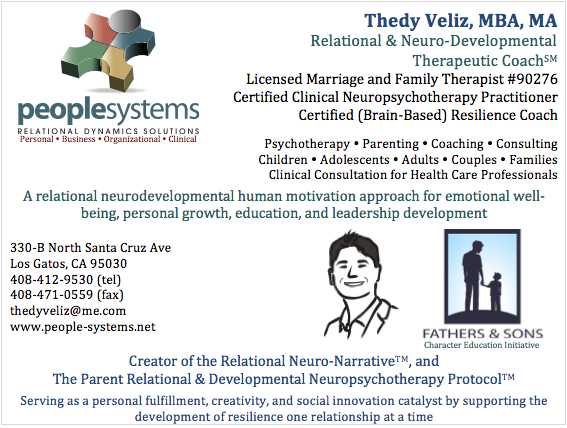Clinical Neuropsychotherapy Explains How Individual Neural Development Affects Social Dynamics
“When self-determined, people experience a sense of freedom to do what is interesting, personally important, and vitalizing”
- Edward Deci & Richard Ryan. Self-Determination Theory website assessed on 11/20/13
When I was in college, I chose to take several courses in psychology not because I was interested in helping people improve their emotional and relational dynamics, but because I suspected that the type of leader a person becomes is affected by their childhood and what I now call the ‘primitive narrative’ that children start to create early on. As I started working as a petroleum engineer after college, it became very evident to me that leadership was a big problem in organizations. After attending the Visionary Life weekend seminar at the Esalen Institute in 2002, not only was I afraid that my understanding of my childhood dynamics might have been getting in the way of my adult relationships, I also wanted to find a way to assist the executives that I had been supporting as part of my corporate finance assignments develop an alternative adult version of their primitive narrative (what I now call a Relational Neuro-Narrative™) because my sense was that many suboptimal decisions were being made because of internal emotional and relational dynamics and not because of lack of technical knowledge. Thus, initially I was interested in working only with adults as I felt that adults are the ones that collectively create the social dynamics that affect our society. In essence, individual people with all their ‘primitive narratives’ create our social reality.

Due to my life experiences, I knew that I did not just want to help people because it would feel good to do so… Instead, I knew I had somewhat of a hidden agenda. If I could help people in leadership positions, through a trickle down effect I would indirectly be helping improve the social fabric. That seemed pretty exciting to me. I now needed the research that would validate that this would be the case. The weekend seminar at the Esalen Institute in 2002 had gotten my attention as it pertained to the importance of relationships for individual fulfillment. But, did individual fulfillment translated to a better society? I set out to find the answer to this question, and along the way I found the field of study that was the perfect sister to attachment theory.

SDT’s research findings were to me an extension of attachment theory findings as the fulfillment of the basic inherent needs (SDT’s terminology) appeared to be directly correlated to a secure attachment style. This was important to me because this tied back to the concern I had in my mind when I was seven years old related to why people hurt one another as I listened to the news pertaining to the Iran-Irak war with my dad. It was important for me to dedicate my life to something that would somehow address this childhood concern of mine. Since that initial concern when I was seven, I first thought the answer was in education, leadership, technology and business. But my weekend at the Esalen Institute in 2002 had made me realize that there was a more ‘soft’ relational component that I had been missing, and that relational component was related to the story we create about ourselves in childhood which gives us a template about ourselves, others and the future.
Most importantly, if this story is not revisited when our brain is more sophisticated to provide the time and context that the child was unable to be aware of while encoding and storing his story, we might end up being adults with the perspective of a child. If I had missed this critical ingredient, my sense was that many more people might have also missed it. And so, it turns out that people whose primitive narratives have not been upgraded to what I call a Relational Neuro-NarrativesTM end up having difficulty trusting themselves and others. In many cases, their default mode of operating is to adopt an us vs. them approach as adults, and this has huge societal implications pertaining to conflicts between people with different backgrounds. In the words of Robert Sapolzky, who is a professor of neurological sciences at Stanford University, we are not autonomous but rather biological creatures (Sapolsky, 2016).

Starting with his doctoral dissertation, Ed Deci had been studying human motivation and most specifically the differences in outcomes pertaining to intrinsic versus extrinsic motivation. Eventually, Deci partnered with Richard Ryan and together spearheaded the development of Self-Determination Theory (SDT), the most comprehensive and researched theory of human motivation, development and health (Deci & Ryan, 2008).
“SDT is an approach to human motivation and personality that uses traditional empirical methods while employing an organismic metatheory that highlights the importance of humans’ evolved inner resources for personality development and behavioral self regulation. Thus, its arena is the investigation of people’s inherent growth tendencies and innate psychological needs that are the basis for their self-motivation and personality integration, as well as for the conditions that foster those positive processes” (Ryan & Deci, 2000, p. 68).

I was thrilled when I realized that SDT explains attachment theory in the broader sociocultural context. And, like attachment theory, SDT is very well researched. SDT’s researchers have concluded that if people are not able to satisfy their basic inherent needs for competence, relatedness, and autonomy; not only does the individual human being suffers, but also society as a whole (Kasser et al., 2007). While completing my masters in counseling psychology at SCU, I used my university library privileges to obtain as many publications pertaining to SDT. I even took an independent research course through which I designed a research study combining both SDT and attachment theory. SDT’s research findings convinced me that my interest in assisting client’s with their emotional challenges was not only about making the individual fulfilled, but that this would in turn carry out into making society a better place. And this was the answer I was hoping I would get. SDT’s research has been applied to the fields of education, healthcare, psychotherapy, parenting, organizations, sports and exercise, materialism, mindfulness, religion & spirituality, politics, media & communications, environmental sustainability, and neuropsychology.

References
- Deci, E. L., & Ryan, R. M. (2008). Self-determination theory: A macrotheory of human motivation, development, and health. Canadian psychology/Psychologie canadienne, 49(3), 182.
- Kasser, T., Cohn, S., Kanner, A. D., & Ryan, R. M. (2007). Some costs of American corporate capitalism: A psychological exploration of value and goal conflicts. Psychological Inquiry, 18(1), 1-22.
- Ryan, R. M., & Deci, E. L. (2000). Self-determination theory and the facilitation of intrinsic motivation, social development, and well-being. American psychologist, 55(1), 68.
- Sapolsky, R. M. (2017, July 11). Why and how we act. In conversation with Dacher Keltner. City Arts and Lectures, 5/22/17, Nourse Theater, San Francisco, CA. Broadcasted on KQED on 7/9/17.
